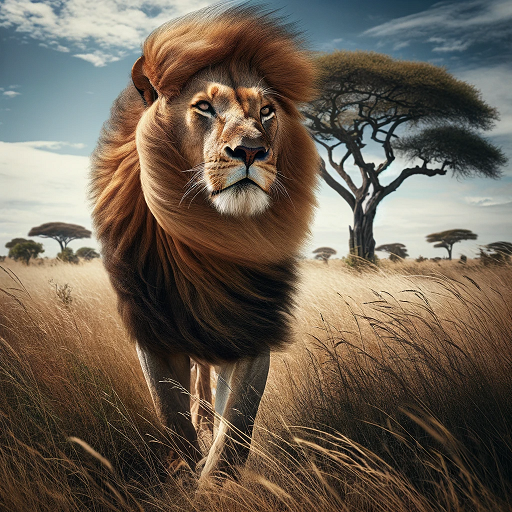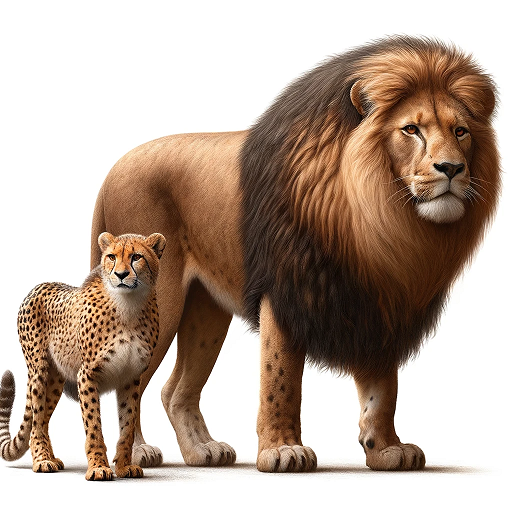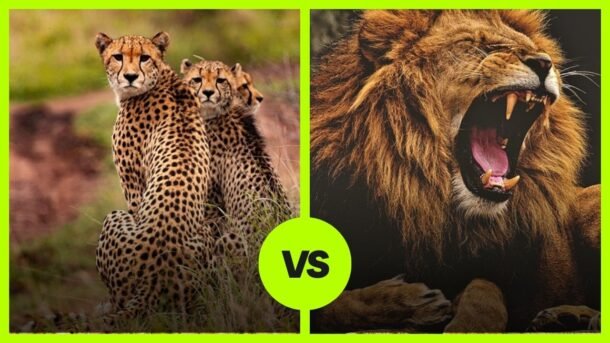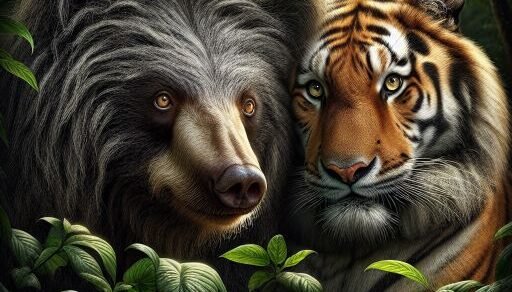In the endless plains of the African savanna, two iconic predators stand tall: the cheetah, celebrated for its breathtaking speed, and the lion, revered as the King of Beasts. While both are apex predators, their lifestyles, physical attributes, and hunting strategies are markedly different. The hypothetical face-off between a cheetah and an African lion provides a captivating case study of nature’s engineering. Let’s delve into the intricacies of their combat capabilities, lifestyles, and tactics to determine who might come out on top in this electrifying duel.
Cheetah: The Fleet-Footed Hunter
Renowned as the world’s fastest land animal, the cheetah can accelerate from 0 to 60 miles per hour in a matter of seconds. Weighing between 75 to 160 pounds, it’s a specialized predator built for speed, not endurance or brute force. Its unique body structure includes large nasal passages for efficient oxygen exchange and non-retractable claws for better traction during sprints.
Evading Lions: Cheetahs often lose their kills to lions. In observed incidents, cheetahs have been seen immediately abandoning their prey at the first sign of a lion approach, prioritizing their safety over the meal. Their agility and speed are key in quickly creating distance from the more powerful lion.
African Lion: The Regal Predator
The African lion is a symbol of strength and majesty. Adult male lions can weigh between 330 to 550 pounds, dwarfing the cheetah in size and strength. Known for their social behavior, lions live in prides and often participate in coordinated hunts. Unlike cheetahs, lions are built for power, equipped with muscular bodies, retractable claws, and incredibly strong jaws.

Cheetah’s Speed and Agility
The cheetah’s claim to fame is its unrivaled speed. However, this speed is only sustainable over short distances, and it requires a cooling-off period afterward. In a combat scenario, the cheetah would likely try to use its speed to dodge attacks and perhaps aim for quick, precise strikes.
Gazelle Hunt: Cheetahs are renowned for hunting Thomson’s gazelles in the African savanna. A classic example involves a cheetah using its incredible speed to chase down a gazelle, executing rapid turns and bursts of speed to match the gazelle’s evasive maneuvers. This chase often ends with the cheetah using its momentum to knock the gazelle off balance, followed by a swift bite to the throat.
Lion’s Strength and Endurance
On the other side, the lion’s physical attributes are geared towards raw power. Its strong build enables it to wrestle down and overpower opponents. The retractable claws can inflict deep wounds, and its powerful jaws can deliver a fatal bite.
Fighting Styles: Quick Strikes vs. Power Plays
Cheetah’s Hit-and-Run
In a battle, a cheetah would have to rely on hit-and-run tactics. Due to its lighter build and lack of physical strength compared to the lion, direct engagement would be almost suicidal.

Lion’s Dominance and Control
The lion, accustomed to taking on large and formidable foes like buffalo, would most likely opt for a frontal assault, aiming to immobilize the cheetah with its strength and powerful claws.
Lions Hunting and Confrontations
- Buffalo Hunt: Lions are known for taking down large prey like African buffaloes. A notable example involves a pride of lions working together to isolate a buffalo from its herd. While one lion latches onto the buffalo’s back, others attack the legs and underside, bringing the massive animal down.
- Elephant Calves Predation: In regions like Botswana, prides have specialized in hunting young elephants. These hunts are risky and require a coordinated effort from the pride, targeting elephants that stray too far from the protection of their herd.
- Giraffe Ambush: Lions have been observed hunting giraffes by using the cover of darkness. They often target younger or injured giraffes, using the element of surprise and their collective strength to overpower these tall creatures.
- Territorial Battles with Rival Prides: Lions often engage in fierce battles with other prides to defend or expand their territory. These confrontations can be brutal, with male lions at the forefront, using their size and strength to assert dominance.
- Confrontations with Hyenas: Lions and hyenas frequently come into conflict over kills. Lions, with their superior size and strength, often dominate these encounters, but hyenas, when in large numbers, can challenge and sometimes drive lions away from kills.
Environmental Considerations
The setting could influence the outcome of the fight. In an open plain, the cheetah’s speed would be more advantageous. In contrast, a confined space would limit the cheetah’s mobility, thereby favoring the lion.
Conclusion: A Mismatch of Epic Proportions
Although both animals are magnificent predators, they are designed for different types of hunting and combat. In a one-on-one match, the lion’s superior size, strength, and stamina would most likely overwhelm the cheetah’s speed and agility.
Odds of Winning:
- Cheetah: 5%
- African Lion: 95%
The African lion holds an overwhelmingly advantageous position in this hypothetical match-up. While the cheetah’s speed and agility offer a glimmer of hope for dodging attacks and making quick strikes, the lion’s sheer power and combat experience tip the scales heavily in its favor. It seems that in this battle, the title of King of Beasts would remain uncontested.
How Does Confrontation Between Lion and Cheetah occur?
Confrontations between cheetahs and lions in nature, while not frequent, do occur, typically revolving around competition for resources such as food and territory. Here is how these interactions usually unfold:
In the African savanna, where territories of cheetahs and lions overlap, the main conflict arises from competition over similar prey, like gazelles or impalas. Lions, with their dominant stature, often have the upper hand in such situations. Imagine a cheetah that has just successfully hunted down its prey. Cheetahs, known for their speed and stealth, are efficient hunters, but the exertion of a high-speed chase leaves them needing time to recover.
During this vulnerable period, a lion, either on a patrol or drawn by the activity of scavengers like vultures, may detect the cheetah’s kill. As opportunistic predators, lions are inclined to investigate and, if possible, take over a kill they come across. Upon spotting a lion, a cheetah typically opts to abandon the kill. The cheetah’s slender build, perfect for rapid chases, isn’t suited for combat, especially against a formidable adversary like a lion.
In most cases, the cheetah retreats to avoid a direct confrontation. The lion, using its strength and social structure, often takes over the cheetah’s kill with little resistance. This interaction highlights the cheetah’s survival strategy, where avoiding injury and preserving itself for future hunts takes precedence over defending its catch.
The impact of such confrontations on cheetah populations, particularly in areas with high lion densities, can be significant. The loss of kills to lions and the added stress can affect the cheetah’s ability to nourish itself and raise its young. Most interactions between cheetahs and lions are characterized by avoidance rather than physical battles. Direct aggressive encounters are rare and typically involve the cheetah trying to escape rather than engage.
These confrontations, driven more by opportunism than direct animosity, reflect the complex dynamics of the African savanna, where each species has evolved its own survival strategies in the face of competition and environmental challenges.
For further exploration of animal confrontations, consider these articles:
- “Cheetah vs. Puma: Predator Showdown” – A detailed comparison of the hunting techniques and adaptations of these swift predators. Read more.
- “Lion vs. Rhino: Who Would Win?” – An engaging analysis of the potential encounter between the powerful lion and the armored rhino. Explore the battle.
- “African Lion vs. Crocodile: Jaws of Death vs. King of the Jungle” – A unique look into how these apex predators might fare against each other in a hypothetical clash. Discover the dynamics.




